
St. Stephen's Episcopal Church is a historic parish of the Episcopal Diocese of Pennsylvania, founded in 1823 in Philadelphia, Pennsylvania and located at 19 South Tenth Street, on the corner of Tenth Street and Ludlow Street. St. Stephen's was designed by William Strickland in the Gothic revival style. It is the oldest extant building in Philadelphia in this style and was designed by an architect-engineer best known for Greek Revival buildings, though, like his mentor Benjamin Latrobe, he produced buildings in other "picturesque" styles as well. St. Stephen's first service was held on February 27, 1823. On June 4, 1979, it was added to the National Register of Historic Places. On May 28, 1957, it was designated a historic landmark by the Philadelphia Historical Commission.

Chapel of the Cross is a parish of the Episcopal Church of the United States in Chapel Hill in the Diocese of North Carolina. It is the spiritual home to more than 1,600 communicants, including numerous students studying at the University of North Carolina at Chapel Hill.
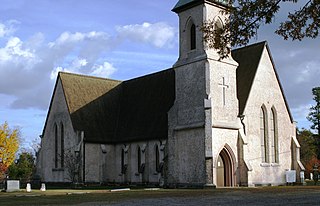
The Church of the Holy Cross is a historic Anglican church at 335 North Kings Highway in Stateburg, South Carolina. Built in 1850-52 to a design by noted South Carolina architect Edward C. Jones, it is a notable example of rammed earth construction with relatively high style Gothic Revival styling. It was designated a National Historic Landmark for its architecture in 1973.

The Church of Our Merciful Saviour in Louisville, Kentucky was established in 1891. The church is located at 473 South 11th Street in Louisville's near west end. This historic church was built in the Late Gothic Revival style and was placed on the National Register of Historic Places in 1983. Today the church is active member parish of the Episcopal Diocese of Kentucky and serves mostly the African American community.

Trinity Episcopal Church is a historic church in Mobile, Alabama, United States. It was the first large Gothic Revival church built in Alabama. The building was designed by architects Frank Wills and Henry Dudley.

Edward Brickell White, also known as E. B. White, was an architect in the United States. He was known for his Gothic Revival architecture and his use of Roman and Greek designs.
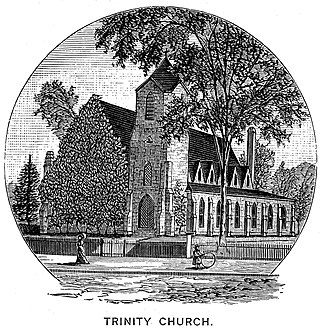
Trinity Episcopal Church was a historic church located at 48 Main Street in Pawtucket, Rhode Island. Built by the Episcopalians, the building was sold to the Catholics in 1977 and became the St. George Maronite Catholic Church within the Diocese of Providence. The church burned down in 2005, and was not rebuilt.
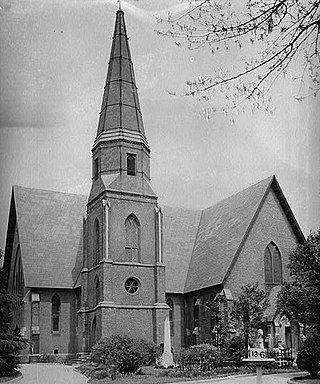
Christ Church (Episcopal) is an Episcopal church in Greenville, South Carolina, United States. which was consecrated in 1854. The church and its courtyard are listed on the National Register of Historic Places as Christ Church (Episcopal) and Churchyard. It is the oldest organized religious body and the oldest church building remaining in Greenville.
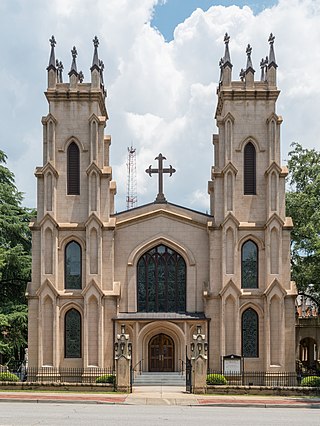
Trinity Episcopal Church, now known as Trinity Episcopal Cathedral, is the first Episcopal and the oldest surviving sanctuary in Columbia, South Carolina. It is a Gothic Revival church that is modeled after York Minster in York, England. It was named to the National Register of Historic Places on February 24, 1971.
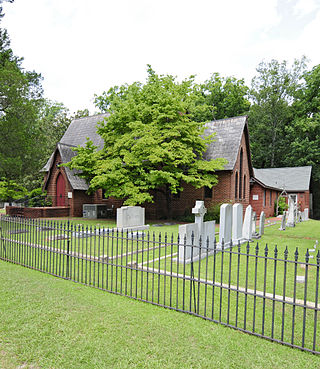
St. Stephen's Episcopal Church is an historic Episcopal church building located northeast of Ridgeway, South Carolina, on County Road 106. Built of wood in 1854 in the Carpenter Gothic style, it was designed by the Rev. John Dewitt McCollough, who later became its rector. The exterior was painted a maroon color. In 1920, its exterior wood was covered by brick veneer, so that it appears today as a brick Gothic Revival style building on the outside while the interior retains its Carpenter Gothic features. A wing was added in the 1940s to create space for a parish hall and Sunday school.

Jonesboro Union Church is a historic church on Looks Point Road, at the junction with U.S. Route 1 in Jonesboro, Maine. Built in 1841 and significantly restyled in 1911, it is the community's only surviving 19th-century church. It is also notable for its eclectic blend of architectural styles, and is an important early ecclesiastical work of Portland architect Edward Leander Higgins. It was listed on the National Register of Historic Places in 2002.

Holy Trinity Episcopal Church also known as Holy Trinity Memorial Church is an historic Episcopal church building located at 38 Grand Avenue in the village of Swanton, Franklin County, Vermont. Built in 1876 and expanded in 1909-10, the church facilities include a fine example of the Carpenter Gothic in the older section, and the Late Victorian Gothic Revival in the newer section. The church was listed on the National Register of Historic Places as the Parish of the Holy Trinity in 2001. The church is an active parish in the Episcopal Diocese of Vermont; its current rector is the Rev. Reid D. Farrell.
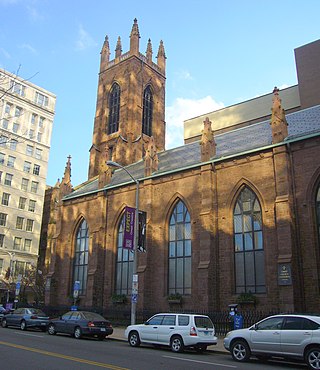
Christ Church Cathedral is a historic church at 955 Main Street in downtown Hartford, Connecticut. Built in the 1820s to a design by Ithiel Town, it is one of the earliest known examples of Gothic Revival architecture in the United States. It was listed on the National Register of Historic Places in 1983. It is the cathedral church of the Episcopal Diocese of Connecticut, whose offices are next door at 45 Church Street.

St. Michael's Episcopal Church, Parish House and Rectory is a group of architecturally-significant religious buildings located at 200-216 North Mill Street in Birdsboro, Berks County, Pennsylvania. It was added to the U.S. National Register of Historic Places in 1982.

Trinity Episcopal Church is a parish church in the Episcopal Diocese of Iowa. The church is located in Iowa City, Iowa, United States. It was individually listed on the National Register of Historic Places in 1974. In 2021, the building was included as a contributing property in the Iowa City Downtown Historic District.
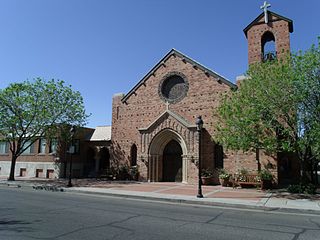
The First United Methodist Church of Glendale, formerly known as the First Methodist Episcopal Church of Glendale in historical documents, is a United Methodist church located at 7102 N. 58th Dr. in downtown Glendale, Arizona, and was built during 1928–29. Its sanctuary, with its linked administration wing, was listed on the National Register of Historic Places in 2006 for its architecture.

The Downtown Churches Historic District is a historic district in downtown Sheboygan, Wisconsin consisting of four churches and five other buildings associated with the churches. The four churches which comprise the district are Grace Episcopal Church, built in the High Victorian Gothic style in 1871; First Methodist Episcopal Church, built in 1929–30 in the Late Gothic style; Hope Reformed Church, built in 1937 in the Late Gothic style; and St. Martin Lutheran Church, built in 1968 in a contemporary style. The churches serve as historical examples of a century's worth of religious architecture spanning four different faiths and a variety of styles. In addition, the first Boy Scout troop in Wisconsin was founded in Grace Episcopal Church in 1911. The district was added to the National Register of Historic Places on March 1, 2010.
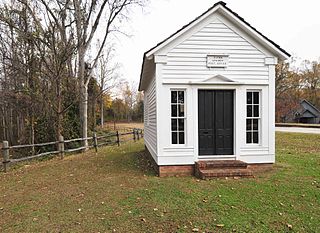
Glenn Springs Historic District is a national historic district located at Glenn Springs, Spartanburg County, South Carolina. It encompasses 18 contributing buildings and 3 contributing sites in the historic health resort of Glenn Springs. The community developed as a resort around the mineral springs between about 1840 and 1940. The district includes several residences, two boarding houses, Cates House Ruins, Calvary Protestant Episcopal Church, Presbyterian Church, Cates Store, Glenn Springs Post Office, a pavilion, a cemetery, and the site of the Glenn Springs Hotel. It includes notable buildings in the Greek Revival, Gothic Revival, Queen Anne, and Bungalow styles.

Delphi Methodist Episcopal Church is a historic Methodist Episcopal church complex located at Delphi, Carroll County, Indiana. The brick and limestone trimmed Gothic Revival style church sanctuary/auditorium was constructed in 1869 with alterations in 1884, 1897, and 1926. It features a massive three-story bell tower on its northeast corner. The education wing was constructed in 1926 in the Collegiate Gothic style. Also on the property is the two-story, Second Empire style brick parsonage constructed in 1897.

All Saints' Episcopal Church is a historic Episcopal parish church in Austin, Texas, United States. Built in 1899 on the edge of the University of Texas at Austin campus, the church has long-standing connections with the university's student body and faculty. The chapel was a project of Episcopal Bishop George Herbert Kinsolving, whose crypt is located under the church. It has been designated as a City of Austin Historic Landmark since 1980 and a Recorded Texas Historic Landmark since 2014, and it was listed on the National Register of Historic Places in 2015.
























